30 Email Etiquette Rules Every HR Should Know
Following basic email etiquette is crucial, especially in the corporate sector. Email is truly a powerful means of communication, both personally and professionally. Excellent email etiquette includes impeccable writing skills making a difference between a fruitful workplace relationship and a potential misunderstanding, offense, or conflict.
Read our blog on: The Guide To Conflict Resolution In The Workplace
Definition of Email Etiquette
Email etiquette is the code of conduct that guides behavior when composing or responding to emails. You can tweak email etiquette rules to fit the intended audience and purpose. But they're all meant to keep things professional and show respect and understanding between email correspondence.
Advantages Of Following Email Etiquette
-
The first advantage of using appropriate email etiquette is that it portrays the professional behavior of the company and the employee.
-
Email etiquette also aids with communication clarity.
-
Furthermore, correct email etiquette can provide the sender and their company with liability protection.
All of these points can be magnified if your staff is constantly working remotely.
With remote work becoming the new normal, now is a great time to invest in some "HR Education" and brush up on email etiquette basics.
Also read: Managing Remote Employees? 7 Key Steps You Must Follow!
It's safe to assume that everyone who reads this blog has gotten an email that has left them speechless. It might be because of how nicely it was framed. Or, it might be because you wished you could write emails like that.
As human resources professionals and managers, you must understand the importance of email etiquette. It can be an inappropriate subject or full of misspelled and poorly chosen words. You should know the detrimental effects a poorly crafted or ill-timed email would have on a business.
The ideal email communication depends on various aspects-
- whether you're writing to a superior or a peer,
- whether you're writing to one or several recipients and
- whether you're emailing across cultures.
We would like to prepare you for the time when you have to send or revert a corporate message. Let's take a look at the 30 email etiquette rules you must apply.
30 Email Etiquette Rules Every HR Professional Should Know
1. 'Dear' or a 'Hi,' or nothing at all?

This is a basic email etiquette that you must know.
You might be thinking why it's so important to consider how you begin your emails. Have you ever received an email that has your name misspelled? If yes, you know how important it is to get your email salutation correctly. You also don't want an overly enthusiastic greeting.
Here are a few quick tips.
- If you are writing an HR email to someone, act more professionally than you typically would. It entails mentioning the person's title to greet them professionally.
- If you're writing to a close colleague or a member of your team, a simple "Hi" would probably suffice.
- It's ok to skip greetings if you're replying to a previous email thread. It is suitable only when you are in an established context.
2. Be careful in using humor.
Something perceived as funny when spoken may come across very differently when written. When in doubt, leave it out. -Patcher
Be mindful that your colleagues working remotely may misinterpret witty sayings in your emails. Without the correct tone or facial gestures, one can easily misinterpret humor.
Unless you know the recipient well, it's best to leave humor out of emails in a professional setting. Also, your idea of funny might differ from someone else's idea of funny. Save your humor for in-person conversations so that others can pick up on your tone.
Anger management is also an integral part of email etiquette. If you write angry emails, you risk insulting someone you work with or care about.
Here's what Linsey Pollak, the author of Getting From College to Career has to say:
E-mailing with bad news, firing a client or vendor, expressing anger, warning someone, criticizing other people in e-mails (particularly if you're saying something less than kind about your boss) are all major no-no's. Because e-mail can seem so informal, many people fall into this trap. Always remember that e-mail correspondence lasts forever.
3. To use or not to use emojis?
Emojis can be a fun way for coworkers to bond. It is that underrated factor that aids in team building. But according to one survey, 39% of senior managers believe that using emojis in work-related interactions is unprofessional.
This email etiquette depends on your company's norms, but be aware of when and to whom you send emojis. If you're sending them to people you know well and will comprehend them, then that is ok. If not, think about avoiding using emojis altogether.
To protect the organization and its employees from misunderstandings, it's a good idea to set an emoji policy.
4. Avoid embarrassing grammar and spelling mistakes.
Avoiding grammar and spelling mistakes is one of the best practices for email etiquette.
A poorly written document affects your credibility. It doesn't have to be perfect. If you are missing a comma here or there, people will barely notice. However, when the mistakes accumulate, it sends a message of laziness and incompetence. - Ken Schlechter.
Your colleagues can get irritated by emails that contain spelling and grammatical problems. They might infer that you're uneducated, careless, or lazy to use the spell checker before sending your message. Before you send your emails, re-read, proofread, spell check, and check for recommended grammatical errors.
5. Choose the right colors and fonts.
An email with a lot of bold, italics, and underlined text may appear aggressive or even unpleasant. While these features can be used to highlight a point, having too much of it can become a decrease the readability.
For one email, use only one or two fonts. If you use too many fonts in your email, it will appear complicated. Try to use the best font for email at your exposure which look professional.
Don't use all CAPITAL characters. IT APPEARS AS IF YOU ARE YELLING AT THE RECIPIENT. Doesn't it?
Use colored text if only it is absolutely essential (especially the red font, as it can be perceived as shouting).
6. Put the right subject line.

While on leave a few weeks ago, I received an email with a subject line that began with "Need reaction urgently:" followed by the email's subject. I read it right away and replied as soon as I could. I did so because the subject line stood out among the rest of the unread emails. Part of me wondered what was so urgent that it couldn't wait, and another part of me was worried that something had gone wrong somewhere and needed fixation right away.
So, always provide a subject line that summarises the subject of your email. Include this in the subject line if your email is urgent or demands a quick response, but do it judiciously. If your email isn't urgent, the crying wolf will irritate people.
Here are three additional tips-
- Write the subject line in the newspaper headline style to attract readers to read what's inside.
- For monthly old conversation threads, state your current subject matter clearly and concisely.
- Insert a descriptive prefix before the actual subject line.
7. Be clear and concise.
HR communications emails may include a long thread of messages and replies. You should avoid replicating the same information, queries, and requests over and over.
You should have a goal and a clear call to action in every email you send. Be brief, and double-check that the email clearly states what you want from respondents.
8. Use visual elements to engage readers.
Employees disregard the majority of their HR emails. It is because HR communications emails are often text-based. Why not incorporate visual elements to increase engagement?
We absorb visuals and interactive material better. So, using infographics, GIFs, or short videos in HR communications can vastly improve employee communication.
79% of respondents read a PS first.
Another strategy in email etiquette is to include a PS at the end of your emails. It creates urgency and improves the persuasiveness of your argument. You can use it to urge further thought or to make a call to action.
9. Design a perfect email signature.
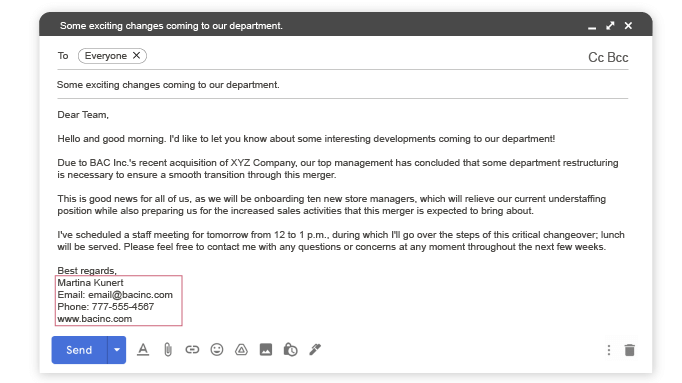
Email conversations with poorly designed signatures can be difficult to follow, resulting in misunderstanding and visual confusion. A typical email signature must include your name, job title, company website or LinkedIn URL, and phone number.
It's recommended to stick to your corporate colors when setting your signature. It will strengthen your brand identity.
10. Rethink the phrases you use.
Use words that everyone is familiar with. You should avoid excessively long sentences.
Avoid slang, and keep technical terms to a minimum.
Forget about email templates if you want to comply with email etiquette. They won't work with HR communications, just like they won't with email outreach. Make use of customized and personalized content that gives value to your staff. Also, make sure to send messages to the appropriate people at the right time.
Always use active verbs and avoid adverbs like "really, very," and so on. They make your message appear hazy.
11. Don't keep anyone waiting for your reply.
In an era of immediate responses, it's harder for us to say, 'I will respond when it is appropriate for me and when I have time.
People hate being overlooked. You can compose a brief note acknowledging receipt of their email and promising to respond at a specific time. Often, this is sufficient to resolve the expectation issue. So, even if it's to acknowledge an email, the common courtesy is to reply within 24 hours.
12. Check the usage of shorthand.

Often, HR use words like ASAP, FYI, and so on. Even if the abbreviations are evident in your knowledge base, keep in mind that not everyone knows them. Mainly, it happens when you don't have a pre-existing relationship with the receiver. In such cases, you must send a brief glossary before sending shorthand emails.
But suppose you already have a relationship with the recipient. In that case, you can learn how to create an email that's brief, informative, and with a list of bullet points.
Remember, in a professional setting, no one should have to Google anything to comprehend what you're saying.
13. Know the use of CC.
We often believe that by 'CC'ing' our colleagues, we are 'keeping them in the loop.' But this isn't necessarily the ideal approach. First, the recipient must read through the message to determine why they received it. It will entail going through an entire thread of messages, which wastes time and may lead to further inquiries.
Therefore, you should double-check that you're only communicating with the people whom you need to share with. If you get copied into every email or see every response in a chain that is not related to your recipient, it might get inconvenient. This factor makes it an essential email etiquette to follow.
Here's another similar suggestion by Duncan-
Do not hit "reply all" unless every member on the e-mail chain needs to know. You want to make sure that you are not sending everyone on a list your answer; whether they needed to know or not.
14. Customize the introduction.
Do not assume the person receiving your e-mail knows who you are or remembers meeting you. If you are uncertain whether the recipient recognizes your e-mail address or name, include a simple reminder of who you are in relation to the person you are reaching out to; a formal and extensive biography of yourself is not necessary. - Peggy Duncan, personal productivity expert and author of Conquer Email Overload with Better Habits, Etiquette, and Outlook 2007.
In the initial few words, introduce yourself by first and last name, as well as the company you represent, depending on who you're addressing. It is vital when emailing new contacts, clients, potential consumers. Explain why you're contacting the person in a few words. Include how you got their contact information and how you got to know them.
However, as a part of email etiquette, the first paragraph should also focus on the recipient. If you begin with a compliment, you are more likely to capture their interest. You may say something particular about their work that. It's a good idea to start with a shared interest.
15. Learn email etiquette of different countries.
The correct email etiquette varies significantly from country to country.
Suppose you're sending an email to a colleague in Germany. In that case, you already know that the email must be highly official. Germany is one of those countries that takes its titles very seriously.
For countries like the United States, emails should be concise and to the point of business. Thus you must know to draft your email with more personal cultural touches. It will show that you care about their culture and can help you communicate more effectively.
16. Watch your tone.
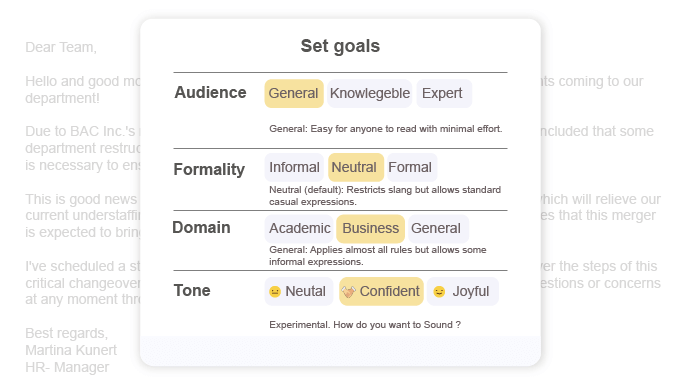
In order to communicate effectively via emails, you must be able to express yourself efficiently, and politely. Here comes the importance of watching your tone.
You must be wondering what a tone in writing is? It is the voice of the written word, reflecting emotion, personality, volume, accent, and the message's overall attitude.
It's essential to have a tone in your emails because it lacks the advantage of facial expressions and our actual voices. Avoid negativity, sarcasm, and adjectives that make you appear overly emotional. Be conscious of every word you say and how it may be perceived.
Review what you wrote and ask yourself,
"Does it sound negative?" Is that what I'm trying to communicate?
Read our blog on: The Leadership Power Of Managing Emotions
17. Use exclamation points sparingly.
The maximum number of exclamation points in a business e-mail? One. Otherwise, you risk looking childish and unprofessional. -Pollak
There are no hard and fast rules on when you should use the exclamation point. But honestly, this punctuation should only be used when you genuinely want to express a sense of excitement or joy. So, sending a short note to a coworker stating, "Congratulations on the promotion!" is appropriate.
18. Only debate public concerns.
This one is the most important email etiquette you must know.
We've all heard the stories about a "private" e-mail that ended up being passed around to the entire company. And in some cases, it spreads all over the Internet.
One of the most important things to consider when it comes to e-mail etiquette is whether the matter you're discussing is public or private. Ask yourself if the topic being discussed is something you'd write on company letterhead or post on a bulletin board for all to see before clicking send. -Judith Kallos, author of E-Mail Etiquette Made Easy, E-Mail: The Manual, and E-Mail: A Write It Well Guide.
Practicing email etiquette will help HR and other employees stay aware of the potential risks.
19. Use caution when dealing with confidential information.
Refrain from discussing confidential information in e-mails such as someone's tax information or the particulars of a highly sensitive business deal. Should the e-mail get into the wrong person's hands, you could face serious - even legal - repercussions. -Peter Post, director of the Burlington, Vermont-based Emily Post Institute.
20. Handle attachments with care.
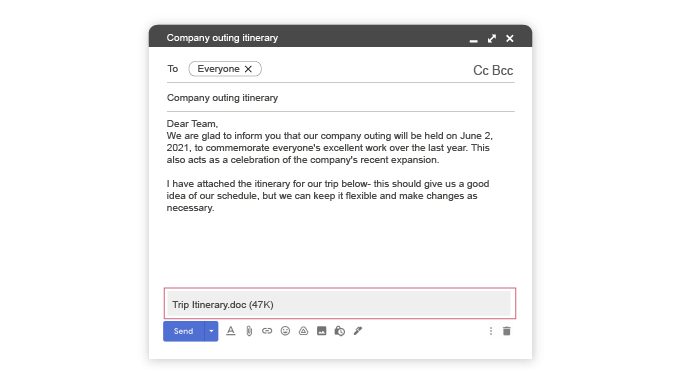
Sending huge attachments without warning might overload the recipient's inbox and cause essential e-mails to bounce.
It would help if you inquired before sending something more than 500KB. For example, if you're sending a large PowerPoint presentation, large image files, or a video, compressing them in a zip file before sending is an excellent idea.
We don't recommend more than two attachments unless it's been specifically asked. Give the attached file(s) a descriptive name so the recipient may easily spot the subject.
21. Don't use email for last-minute communication.
You should never use email for last-minute cancellations of meetings, lunches, or interviews. You should also not use it for passing on bad news. In that case, a phone call is best. But, if you need to communicate information to many people, e-mail is a better option.
22. Use an auto-responder only when absolutely necessary.
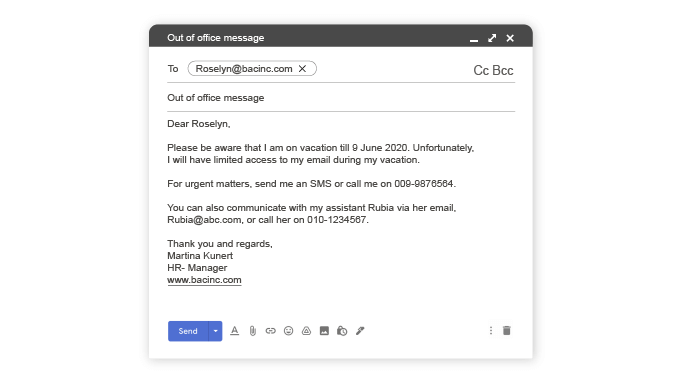
An automatic response that says, "Thank you for your e-mail message. I will respond to you as soon as I can" is useless. However, one thing these messages do great is alert spammers that your e-mail is real and that they can add you to their spam list. -Peggy Duncan, personal productivity expert and author of Conquer Email Overload with Better Habits, Etiquette, and Outlook 2007.
For example, you should set up an automated out-of-office reply if you'll be out of the office for an extended length of time. It will let people know you won't react to their emails until a specific date. You can use a wide variety of email automation tools for this purpose. Include a phone number where you can be reached in the event of an emergency.
23. Know when to use BCC.
The abbreviation "BCC" stands for "blind carbon copy." The email addresses of the recipients in this field are not visible to one another. Use this email etiquette only while sending an email to only when you send an email to a group of people who don't know each other. If you're introducing someone, using the BCC will confuse everyone. Instead, use the "To" box so that everyone's email is visible.
24. Be careful on sending reminders.
Depending on the sort of inquiry, give the recipient a day or two to answer. When a recipient receives a reminder after being out of the office or in meetings all day, they may feel irritated. Also, before sending reminders, please check your junk or spam folder.
25. Don't forget about the closer phrases.
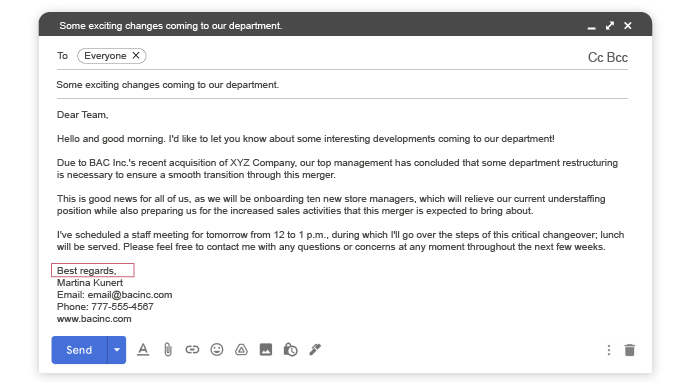
You must include a conversation closer.
"No further response is required," "Thank you again," "See you at the board meeting," or "Please let me know if I can be of help" are appropriate closing phrases.
Finally, don't forget to add terms like "Best," "Best Regards," "Sincerely," "Thank you," or as such.
26. Don't include the "sent from my phone" clause.

Anyone on your contact list will be irritated by the four little words "Sent from my iPhone." Some individuals consider the automated signature to be impolite, as it implies that you don't have the time or energy to sit down and produce a thoughtful answer to whomever you're emailing. Try to limit this clause in your professional emails.
27. Don't ask for delivery and read receipts.
It is almost always sure to irritate recipients before they even open your message. Furthermore, it is not always effective because some receivers may disable the receipt function, or their email software may not support it. If you want to know whether or not a recipient has received your email, ask them directly.
28. Keep your professional email address short.

Email addresses for organizations should be short, basic, and memorable. For example, for your human resources department, hr@domain.com makes more sense than humanresources@domain.com. It is a good email etiquette that creates an impression, branding, and trustworthiness.
Read our blog on: 6 Practices To Ensure Trust In The Workplace With Employee Engagement Initiatives
29. Double-check the recipient's name.
When you've finished writing your email and are ready to send it, double-check that you're sending it to the right person. It's all too easy to start typing someone's name in the "To" column. Then you click on the first name that displays, only to discover later that you choose the wrong name.
So, always double-check that the email is being sent to the correct person. And always verify email addresses so that you send it to the right recipeint.
Also, just like you should proofread for grammatical problems, it would help if you also double-checked that the recipient's name is spelled correctly. Misspelling someone's name conveys a lack of attention to detail. Whether you're emailing someone for the first or tenth time, double-check if their first and last names are correct along with their professional titles.
30. As a final step, add the recipient's email address.
Pachter says, "You don't want to send an email accidentally before you have finished writing and proofing the message. Even when you are replying to a message, it's a good precaution to delete the recipient's address and insert it only when you are sure the message is ready to be sent." Use an email finder tool to find the correct email address of your recipient and then click "send".
Always remember that your emails are a reflection of you and your organization, no matter whom you're emailing. It's quite important to validate the emails until it comes to writing the messages, that's where email validation comes into play.
It's essential to maintain a professional and respectful approach in all communication, be it email or face to face.
It takes practice and intention to use an email etiquette framework in your daily communications at work. And one thing is certain: mastering the art of email etiquette will make your relationship with peers, vendors, and customers much easier.


















